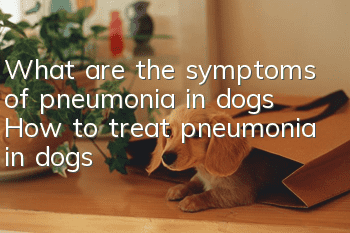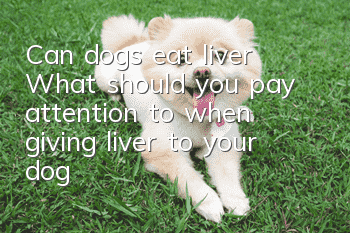What are the symptoms of pneumonia in dogs? How to treat pneumonia in dogs

Beware of dog pneumonia during seasonal changes. Treatment of canine bronchopneumonia. Bronchopneumonia is an inflammation of individual lobules or several pulmonary lobules, also known as lobular pneumonia; the alveoli are usually filled with inflammatory exudative components composed of epithelial cells, plasma and white blood cells. Clinically, the symptoms include relaxing fever, increased breathing frequency, cough, and localized pneumonia lesions in the lungs.
(1) Secondary colds, improper feeding and management, stimulation by physical and chemical factors, and low synthetic resistance create opportunities for various bacteria, such as pasteurella, pneumococci, streptococci, staphylococci and other infections .
(2) Parasitic cause: Ascaris larvae damage the alveoli and bronchi during their migration in the body.
(3) Secondary factors, such as colds, adenovirus, canine distemper, infectious hepatitis and inflammatory transfer to other tissues and organs, can all lead to pneumonia.
【Symptoms】
The disease initially showed symptoms of acute bronchitis, including runny nose, dry cough, and bronchial sounds. As the disease progresses, the general condition worsens, the spirit becomes depressed, the appetite decreases or no food is eaten, the body temperature rises to 39.54 degrees, the symptoms are flaccid fever, dyspnea, increased frequency, conjunctival cyanosis, sunken eyeballs, and dehydration.
During auscultation of the lungs, the alveolar sounds are weakened in the diseased areas, crepitus can be heard, and sounds can be heard in the healthy parts.
Blood changes, total white blood cell count and neutrophils increased, and there was left nuclear shift. X-ray examination shows that the lung texture is thickened and has flaky shadows.
【Treatment】
(1) Penicillin 50,000 units/kg body weight, streptomycin 30,000 units/kg body weight, dexamethasone 0.1-0.3 mg/kg body weight, mixed and injected intramuscularly, twice a day, for 5-7 days.
(2) Tetracycline 10-15 mg/kg body weight, dissolved in 5% glucose, intravenously injected, 2 times/day. Or cephalosporin 56 mg/kg body weight, dexamethasone 0.2 mg/kg body weight, mixed intramuscular injection, 2 times/day.
(3) Supportive therapy, 5% glucose saline 15-30 ml/kg body weight, 5% sodium bicarbonate injection 1-2 ml/kg body weight, mixed intravenous infusion.
(4) Fatan antitussive, ammonium chloride 50 mg/kg body weight, Kebiqing 2.5 mg/kg body weight, taken orally 2 times/day. To relieve asthma, aminophylline 10-15 mg/kg body weight can be taken orally 2 times a day.
(5) When you have difficulty breathing and heart failure, take ephedrine orally. 5-15 mg each time. Aminophylline, 10 mg per kilogram of body weight, administered or intravenously, once every 8 hours. For those with difficulty breathing causing hypoxia, oxygen inhalation should be given. For those with anorexia, intravenous injections are given to replenish body fluids and nutrients.keep.
- How to treat urinary tract stones in dogs? Dogs may need surgery!
- What should I do if my dog has no milk? The owner should check quickly and don’t let the puppies starve to death.
- Dog’s anal gland odor, please note that this is a sign of your dog’s health!
- What are the symptoms of dog pain? How to detect dog pain early
- How to make your dog like to eat dog food Four ways to make your dog fall in love with dog food
- Can dogs digest peach pits if they eat them? Can dogs digest peach pits if they accidentally eat them?
- How to protect your dog’s food? Teach you tips on training your dog
- Why do dogs defecate everywhere? How can dogs stop defecating everywhere?
- What should I do if my dog has lupus? Immune system diseases should not be underestimated
- If your dog's hair is cut and the skin is cut, the flesh is exposed. If the dog's hair is accidentally cut and the skin is cut, it must be disinfected immediately.



